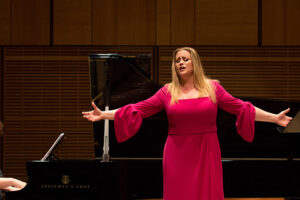

With his head held high and his feet planted firm on the ground: Taylor Mac
When we last saw Taylor Mac in A 24-Decade History of Popular Music, it was exactly one week ago, and the 20th century was still looming. Part 2 begins in 1896 (in a Jewish tenement, nicely balancing “Amazing Grace,” which opened Part I), and continues to the present.
Having done the first 12 hours, I felt like a veteran this time, and pretty much knew what to expect.
Indeed, the format is nearly identical to Part 1, meaning each hour is loosely organized around a decade and a concept: Decade XV is 1916 to ’26, and the focus is speakeasies; Decade XX is 1966 to ’76, with Stonewall as the organizing theme; and so on. You can, of course, do the math yourselves, but the show ends in the present, with Mac playing piano, ukulele, and banjo, and singing original songs that reflect judy’s (TM’s preferred pronoun) take on the current state of the world.
As in Part 1, Mac is the star, but supported by some stellar musicians and other performers. Costuming is fabulously over-the-top, as is the patter. Warmth, humor, and joyful out-and-proud-ness dominate the mood, yet there is considerable darkness in Mac’s view of both past and present. (For a more detailed account of the fundamentals of TM24, see my review of Part 1.)
What was quite different this time was the familiarity of the material. (Last time, even the audience members in their 60s and older—and there were a surprising number—didn’t have instant recall of the jukebox hits of the 1860s.) There was much delighted recognition and singing-along.
For me, knowing so many of the songs was a blessing and a curse. It was fascinating to hear Mac’s performances, newly and often ingeniously re-contextualized.
But I was also more aware than last time of how capricious many of judy’s choices are. Sometimes it seemed that Mac—a diva by any definition—would simply decide a song has a particular resonance because judy wants it to.
In general, I had more mixed feelings about TM24-2. Perhaps it was that some of the novelty had rubbed off (after all, I’d spent 12 hours in judy’s delighful company just seven days before). But while the brilliance of the concept remains as bracing as ever, some of TM24 is less specific and on-point in the second half.
Yet, sometimes—there’s God—so quickly! Just as I settled in to a sense that I would admire but not adore TM24-2, the midpoint brought an hour-plus of such astonishing brilliance that I wouldn’t have missed it for the world.
So, I’ll start there. Here’s my take on TM24-2: the best, and the rest, and the takeaway.
The Best
Unquestionably for me, it’s Decade XVII: 1936-46, subtitled “Prison.” In fact, this particular unit is the apotheosis of Mac’s visionary idea. (If judy follows the announced plan and will continue to perform TM24 in shorter excerpts, I urge you to see this one, above all!)
Mac’s sly brilliance is evident even in the title. The dates would suggest a focus on WWII, but here that topic is largely sidelined.
Instead, judy provocatively examines not bravery and unity, but rather the way in which nostalgic yearning set the stage for American decline.
As a lead in, we have an absolutely lovely rendition of “Stardust,” sung by music director Matt Ray, accompanying himself on the piano, which has the audience sighing with pleasure. When Mac enters, singing “The Trolley Song,” the buoyant mood continues.
Soon, though, we confront a darker underside. Mac performs “Soliloquy” from Carousel as the centerpiece of this section, commenting first that it was a song that traumatized judy in childhood—to perform it now is a ritual of overcoming that trauma.
As Mac sings, we start to understand. I used to find “Soliloquy” sinister because within the plot of Carousel, it prefigures a disastrous decision by Billy Bigelow that will ultimately cost him his life. Here, though, what’s shocking is how narrowly prescriptive it is about boys and girls.
When the audience bursts into a huge ovation—Mac sings “Soliloquy” idiosyncratically but superbly—we’re aware of the paradox. This is a piece we love (and many of the songs in this section are particularly beguiling). But even as we endorse its power and the performance, we’re also indicating tacit acceptance of oppressive societal norms.
Great as much of TM24 is, Mac’s true revelation is in shining a light on American popular music as a specific example of our culture at its best and worst.
This continues through Decade XVII, where the banal but pretty big band hit, “Sleepy Lagoon” is juxtaposed with an awful chapter in Los Angeles history; and Cole Porter’s “Don’t Fence Me In” takes on unexpected Trump-induced poignancy.
Decade XVIII (1946-56, subtitled “White Flight”) is very nearly as good, at least in parts. And when else will you get to hear “Secret Love,” “The Stripper,” and “Turn! Turn! Turn!” in succession? (Here, too, the titles alone tell much of the story.)
There are other fabulous moments in TM24-2, many of them Mac solos (if anything, judy sounded in better voice here than last week) and patter, which is always masterful. Several guest artists also did terrific work, including blues diva Thornetta Davis, singer-songwriter Toshi Reagon, and the dazzling dance ensemble, Camden Sophisticated Sisters/Distinguished Brothers.
The Rest
Several sequences were too loosely organized, and lacked point. A speakeasy section seemed mostly random, though the Philly audience greatly enjoyed the guest star appearance of local favorite, Martha Graham Cracker. The Harlem Renaissance should have been a high point, but similarly, it didn’t cohere.
By the last couple of hours, Mac’s energy was clearly flagging (though there was remarkably little attrition, and no loss of enthusiasm from the adoring audience). While judy had undoubtedly earned the right to take it easy—and the crowd loved the intimacy of the final hour—Mac’s original songs, though quirky and charming, are not of a level with the rest of the material. (This was particular shown up since it was almost immediately preceded by Reagon’s white-hot delivery of her original songs.)
Also, a number of important points are driven home too often.
The Takeaway
In a sense, it’s futile, even petty to scrutinize TM24. The show is 24 hours long—who wouldn’t expect peaks and valleys? Anyway, theoverwhelming takeaway is positive. The show’s audacity and vision are sui generis; hell, even the annoying bits are remarkable.
TM24 may be gone as a marathon entity, but bits of it will surely live on. No matter which sections are offered, if you have the opportunity to see it, you absolutely should.
More importantly, the contribution of the show as a whole—making us think about our musical history as exactly that: music and history—is pure genius.
Photo: Teddy Wolff























Comments